Authors: Daniel Kim, Ryan Yoon, Jay Jo, Source: Tiger Research, Compiled by: Shaw Golden Finance
Key Points
Institutional adoption of Bitcoin accelerates—U.S. 401(k) investment unlocks, exchange-traded funds (ETFs), and corporate entities continue to increase holdings on a large scale.
The best environment since 2021—global liquidity is at historical highs, with major countries cutting interest rates.
Shifting from retail-dominated to institution-dominated market—despite signs of market overheating, institutional buying firmly supports downside risks.
Global liquidity expansion, institutional accumulation, and favorable regulatory policies drive Bitcoin adoption.
Currently, the Bitcoin market is driven by three core factors: 1) global liquidity expansion, 2) accelerated inflow of institutional funds, 3) a crypto-friendly regulatory environment. These three factors are at play simultaneously, creating the strongest upward momentum since the bull market of 2021. Bitcoin has risen about 80% year-on-year, and we expect few factors in the short term that could disrupt this upward momentum.
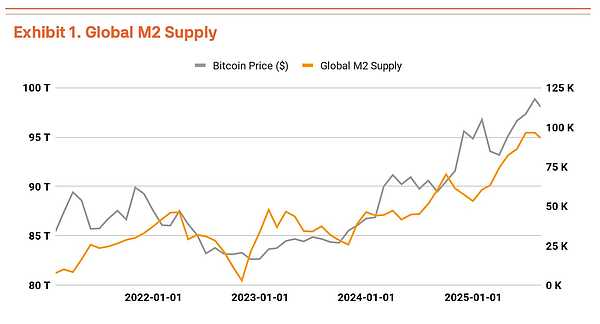
In terms of global liquidity, it is noteworthy that the broad money supply (M2) of major economies has exceeded $90 trillion, reaching a historical high. Historically, the growth rate of M2 has shown a similar trend to Bitcoin prices; if the current monetary expansion continues, Bitcoin still has significant room for appreciation (see Chart 1).
Additionally, the pressure from U.S. President Trump to cut interest rates and the Federal Reserve's dovish stance have opened the way for excess liquidity to flow into alternative assets, with Bitcoin being the main beneficiary.
Meanwhile, institutional investors are accumulating Bitcoin at an unprecedented rate. The 1.3 million Bitcoins held by U.S. spot ETFs account for about 6% of total supply, while Strategy (MSTR) alone holds 629,376 Bitcoins (worth $71.2 billion). The key is that these purchases represent structural strategies rather than one-off trades. Strategy continues to buy through convertible bond issuance, particularly indicating the formation of a new layer of demand.
Moreover, the executive order issued by the Trump administration on August 7 is significant. It allows 401(k) retirement accounts to invest in Bitcoin, opening a funding pool of $8.9 trillion for Bitcoin. Even at a conservative 1% allocation, this would mean an influx of $89 billion—about 4% of Bitcoin's current market value. Given the long-term holding nature of 401(k) funds, this development not only supports an increase in Bitcoin prices but also helps reduce its volatility. This marks a definitive shift of Bitcoin from a speculative asset to a core institutional asset.
Retail activity weakens, institutions drive trading volume.
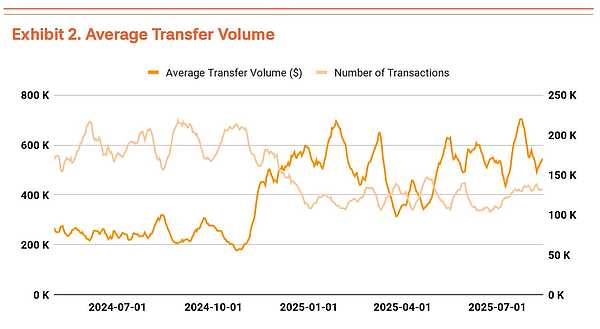
The Bitcoin network is currently reorganizing around large investors. The average number of daily transactions has decreased by 41% from 660,000 in October 2024 to 388,000 in March 2025, but the amount of Bitcoin per transaction has actually increased. Large transactions from institutions such as Strategy have increased, expanding the average transaction size. This indicates that the Bitcoin network is shifting from a 'small, high-frequency' trading model to a 'large, low-frequency' trading model (see Chart 2).
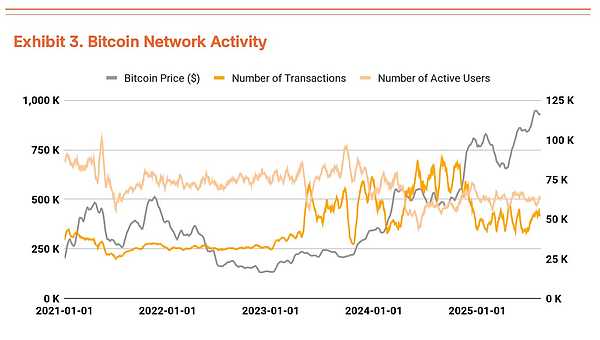
However, the fundamental indicators show uneven growth. Although institutional reorganization has clearly driven the increase in Bitcoin network value, the number of transactions and active users has not yet recovered (see Chart 3).
Fundamental improvements need to be activated through Bitcoin-based decentralized financial services (BTCFi) and other initiatives, but these are still in early development stages and will take time to produce significant impact.
Overbought, but institutions provide support.
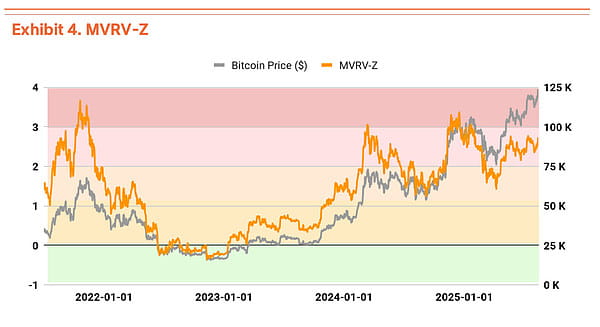
On-chain indicators show some signs of overheating, but significant downside risk remains limited. The MVRV-Z indicator (which measures the ratio of current price to the average cost basis of investors) is currently in the overheating zone at 2.49, recently spiking to 2.7, warning of a possible pullback in the short term (see Chart 4).
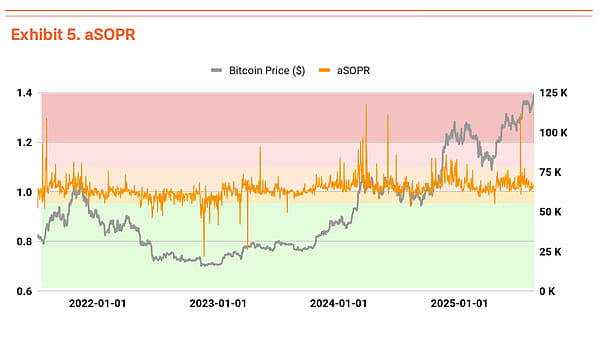
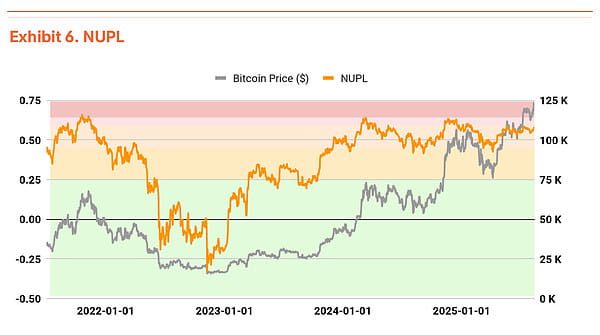
However, the aSOPR (1.019) tracking realized gains and losses for investors and the NUPL (0.558) measuring unrealized gains and losses across the market are both in stable ranges, indicating a healthy overall market (see Charts 5, 6).
In short, although the current price is high relative to the MVRV-Z indicator, actual selling occurs at moderate profit levels (aSOPR), and the overall market has not yet entered the excessive profit region (NUPL).
Supporting this strong momentum is institutional investor buying exceeding that of retail. ETFs and strategy entities continue to accumulate, providing solid support for prices. A pullback may occur in the short term, but the likelihood of a trend reversal seems low.
Target price of $190,000, with an upside potential of 67%.
Our TVM method derives a target price of $190,000 through the following framework: we first establish a base price of $135,000 (removing extreme fear and greed from the current price), then apply a 3.5% fundamental indicator multiplier and a 35% macroeconomic indicator multiplier.
Fundamental indicator multipliers reflect the improvement in network quality—although the number of transactions has decreased, the transaction value has increased. The macroeconomic indicator multipliers capture three powerful forces: continuous global liquidity expansion (e.g., M2 exceeding $90 trillion), accelerated institutional adoption (e.g., ETFs holding 1.3 million Bitcoins), and improving regulatory environment (e.g., 401(k) plans unlocking eligibility for $8.9 trillion).
At current levels, this implies a 67% upside potential. Although this target may seem aggressive, it reflects the structural transformation Bitcoin is undergoing from a speculative asset to an institutional portfolio allocation.

